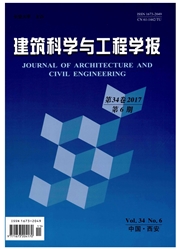

 中文摘要:
中文摘要:
为提高钢筋混凝土柱在快速循环加载下的动力滞回性能数值模拟计算效率并反映局部破坏特征,对通用有限元分析程序ABAQUS进行二次开发,编写了适用于三维纤维梁单元的混凝土和钢筋本构模型程序,在实现纤维梁单元和实体单元界面连接变形协调的基础上,建立了由三维实体单元和纤维梁单元组成的两尺度有限元模型。为了比较计算精度和效率,分别建立了试件的三维纤维梁单元模型和三维实体单元模型。分别对3种模型进行往复荷载作用下考虑混凝土材料应变率效应的钢筋混凝土柱动力滞回性能数值模拟,将两尺度模型的计算结果与试验结果进行比较。结果表明:所开发的材料本构模型程序以及两尺度模型能较好地反映钢筋混凝土柱在快速循环加载下的承载能力及滞回性能;所建立的两尺度模型既可节约计算成本,又能实现钢筋混凝土柱试件关键部位的精细化分析。
 英文摘要:
英文摘要:
In order to improve the simulation efficiency and investigate the local failure pattern of reinforced concrete (RC) column specimens under dynamic cyclic loadings, the subroutines describing the dynamic constitutive laws of concrete materials and reinforcement which were suitable for three dimensional (3D) fiber beam elements were developed in ABAQUS. Then, a two-scale finite element method (FEM) model composed of 3D fiber beam elements and 3D solid elements was established to simulate the dynamic cyclic behavior of the RC column specimens under cyclic loading. In the model, the deformation of the 3D fiber beam elements and the 3D solid elements at the interface was compatible. For comparison, two FEM models for the RC columns specimens composed of the fiber elements and solid elements solely were developed. The simulation results from the two-scale FEM model were compared with the test results firstly. The results show that the two-scale model using the developed subroutines describing the constitutive laws can simulate the load-carrying capacity and the dynamic hysteretic performance of the RC columns under rapid cyclic loading. The two-scale model can limit computation cost and achieve fine analysis of the RC column.
 同期刊论文项目
同期刊论文项目
 同项目期刊论文
同项目期刊论文
 期刊信息
期刊信息
